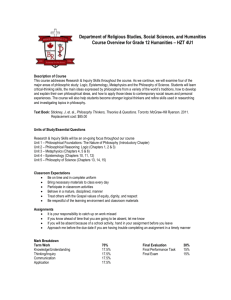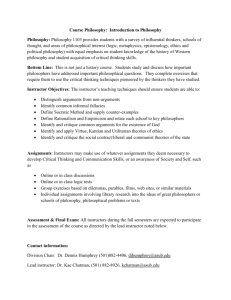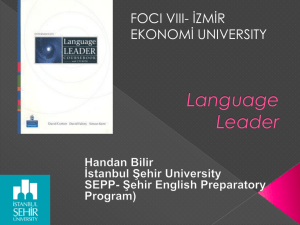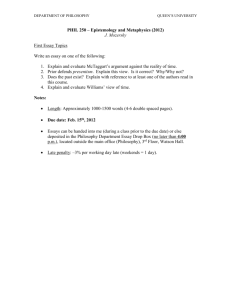Educational Philosophies Part II
advertisement
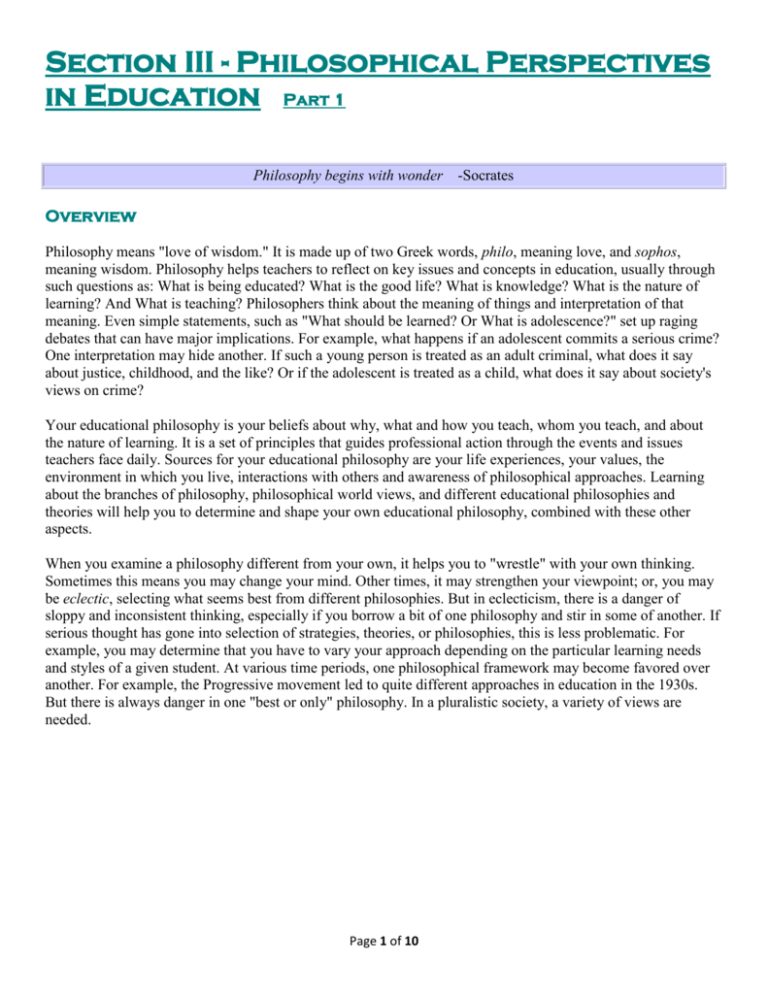
Section III - Philosophical Perspectives in Education Part 1 Philosophy begins with wonder -Socrates Overview Philosophy means "love of wisdom." It is made up of two Greek words, philo, meaning love, and sophos, meaning wisdom. Philosophy helps teachers to reflect on key issues and concepts in education, usually through such questions as: What is being educated? What is the good life? What is knowledge? What is the nature of learning? And What is teaching? Philosophers think about the meaning of things and interpretation of that meaning. Even simple statements, such as "What should be learned? Or What is adolescence?" set up raging debates that can have major implications. For example, what happens if an adolescent commits a serious crime? One interpretation may hide another. If such a young person is treated as an adult criminal, what does it say about justice, childhood, and the like? Or if the adolescent is treated as a child, what does it say about society's views on crime? Your educational philosophy is your beliefs about why, what and how you teach, whom you teach, and about the nature of learning. It is a set of principles that guides professional action through the events and issues teachers face daily. Sources for your educational philosophy are your life experiences, your values, the environment in which you live, interactions with others and awareness of philosophical approaches. Learning about the branches of philosophy, philosophical world views, and different educational philosophies and theories will help you to determine and shape your own educational philosophy, combined with these other aspects. When you examine a philosophy different from your own, it helps you to "wrestle" with your own thinking. Sometimes this means you may change your mind. Other times, it may strengthen your viewpoint; or, you may be eclectic, selecting what seems best from different philosophies. But in eclecticism, there is a danger of sloppy and inconsistent thinking, especially if you borrow a bit of one philosophy and stir in some of another. If serious thought has gone into selection of strategies, theories, or philosophies, this is less problematic. For example, you may determine that you have to vary your approach depending on the particular learning needs and styles of a given student. At various time periods, one philosophical framework may become favored over another. For example, the Progressive movement led to quite different approaches in education in the 1930s. But there is always danger in one "best or only" philosophy. In a pluralistic society, a variety of views are needed. Page 1 of 10 Branches of Philosophy There are three major branches of philosophy. Each branch focuses on a different aspect and is central to your teaching. The three branches and their sub-branches are: Branch Metaphysics: What is the nature Epistemology: What is the nature of of reality? knowledge? How do we come to know? Axiology: What values should one live by? Educational Examples –Do you think human beings are basically good or evil? –What are conservative or liberal beliefs? –How would an anthropologist look at this classroom? A political scientist? A biologist? –How do we know what a child knows? –Is morality defined by our actions, or by what is in our hearts? –What values should be taught in character education? Subbranches –Ontology What issues are related to nature, existence, or being? Is a child inherently evil or good? How might your view determine your classroom management? –Cosmology What is the nature and origin of the cosmos or universe? Is the world and universe orderly or is it marked by chaos? What would one or the other mean for a classroom? Knowing based on: –Scientific Inquiry –Senses and Feelings –From authority or divinity –Empiricism (experience) –Intuition –Reasoning or Logic What reasoning processes yield valid conclusions? –Deductive: reasoning from the general to the particular All children can learn. Bret is a fifth grader. He has a learning disability. Can Bret learn? –Inductive: reasoning from the specific to the general. After experimenting with plant growth under varied conditions, stu-dents conclude plants need water and light –Ethics What is good and evil, right and wrong? Is it ever right to take something that does not belong to you? –Aesthetics What is beautiful? How do we recognize a great piece of music? Art? Can there be beauty in destruction? Think about it: 1. Why might the study of philosophy be particularly important to educators? 2. Which branch or branches of philosophy would you want to emphasize in your classroom? Why? 3. Do you learn better deductively or inductively? Why do you think? 4. Can you think of other school-based examples for each of the branches and sub branches? Page 2 of 10 Section III - Philosophical Perspectives in Education Part 2 Four General or World Philosophies The term metaphysics literally means "beyond the physical." This area of philosophy focuses on the nature of reality. Metaphysics attempts to find unity across the domains of experience and thought. At the metaphysical level, there are four* broad philosophical schools of thought that apply to education today. They are idealism, realism, pragmatism (sometimes called experientialism), and existentialism. Each will be explained shortly. These four general frameworks provide the root or base from which the various educational philosophies are derived. * A fifth metaphysical school of thought, called Scholasticism, is largely applied in Roman Catholic schools in the educational philosophy called "Thomism." It combines idealist and realist philosophies in a framework that harmonized the ideas of Aristotle, the realist, with idealist notions of truth. Thomas Aquinas, 1255-127, was the theologian who wrote "Summa Theologica," formalizing church doctrine. The Scholasticism movement encouraged the logical and philosophical study of the beliefs of the church, legitimizing scientific inquiry within a religious framework. Two of these general or world philosophies, idealism and realism, are derived from the ancient Greek philosophers, Plato and Aristotle. Two are more contemporary, pragmatism and existentialism. However, educators who share one of these distinct sets of beliefs about the nature of reality presently apply each of these world philosophies in successful classrooms. Let us explore each of these metaphysical schools of thought. Idealism Idealism is a philosophical approach that has as its central tenet that ideas are the only true reality, the only thing worth knowing. In a search for truth, beauty, and justice that is enduring and everlasting, the focus is on conscious reasoning in the mind. Plato, father of Idealism, espoused this view about 400 years BC, in his famous book, The Republic. Plato believed that there are two worlds. The first is the spiritual or mental world, which is eternal, permanent, orderly, regular, and universal. There is also the world of appearance, the world experienced through sight, touch, smell, taste, and sound, that is changing, imperfect, and disorderly. This division is often referred to as the duality of mind and body. Reacting against what he perceived as too much of a focus on the immediacy of the physical and sensory world, Plato described a utopian society in which "education to body and soul all the beauty and perfection of which they are capable" as an ideal. In his allegory of the cave, the shadows of the sensory world must be overcome with the light of reason or universal truth. To understand truth, one must pursue knowledge and identify with the Absolute Mind. Plato also believed that the soul is fully formed prior to birth and is perfect and at one with the Universal Being. The birth process checks this perfection, so education requires bringing latent ideas (fully formed concepts) to consciousness. In idealism, the aim of education is to discover and develop each individual's abilities and full moral excellence in order to better serve society. The curricular emphasis is subject matter of mind: literature, history, philosophy, and religion. Teaching methods focus on handling ideas through lecture, discussion, and Socratic dialogue (a method of teaching that uses questioning to help students discover and clarify knowledge). Introspection, intuition, insight, and whole-part logic are used to bring to consciousness the forms or concepts which are latent in the mind. Character is developed through imitating examples and heroes. Realism Realists believe that reality exists independent of the human mind. The ultimate reality is the world of physical objects. The focus is on the body/objects. Truth is objective-what can be observed. Aristotle, a student of Plato who broke with his mentor's idealist philosophy, is called the father of both Realism and the scientific method. In this metaphysical view, the aim is to understand objective reality through "the diligent and unsparing scrutiny Page 3 of 10 of all observable data." Aristotle believed that to understand an object, its ultimate form had to be understood, which does not change. For example, a rose exists whether or not a person is aware of it. A rose can exist in the mind without being physically present, but ultimately, the rose shares properties with all other roses and flowers (its form), although one rose may be red and another peach colored. Aristotle also was the first to teach logic as a formal discipline in order to be able to reason about physical events and aspects. The exercise of rational thought is viewed as the ultimate purpose for humankind. The Realist curriculum emphasizes the subject matter of the physical world, particularly science and mathematics. The teacher organizes and presents content systematically within a discipline, demonstrating use of criteria in making decisions. Teaching methods focus on mastery of facts and basic skills through demonstration and recitation. Students must also demonstrate the ability to think critically and scientifically, using observation and experimentation. Curriculum should be scientifically approached, standardized, and distinct-discipline based. Character is developed through training in the rules of conduct. Pragmatism (Experientialism) For pragmatists, only those things that are experienced or observed are real. In this late 19th century American philosophy, the focus is on the reality of experience. Unlike the Realists and Rationalists, Pragmatists believe that reality is constantly changing and that we learn best through applying our experiences and thoughts to problems, as they arise. The universe is dynamic and evolving, a "becoming" view of the world. There is no absolute and unchanging truth, but rather, truth is what works. Pragmatism is derived from the teaching of Charles Sanders Peirce (1839-1914), who believed that thought must produce action, rather than linger in the mind and lead to indecisiveness. John Dewey (1859-1952) applied pragmatist philosophy in his progressive approaches. He believed that learners must adapt to each other and to their environment. Schools should emphasize the subject matter of social experience. All learning is dependent on the context of place, time, and circumstance. Different cultural and ethnic groups learn to work cooperatively and contribute to a democratic society. The ultimate purpose is the creation of a new social order. Character development is based on making group decisions in light of consequences. For Pragmatists, teaching methods focus on hands-on problem solving, experimenting, and projects, often having students work in groups. Curriculum should bring the disciplines together to focus on solving problems in an interdisciplinary way. Rather than passing down organized bodies of knowledge to new learners, Pragmatists believe that learners should apply their knowledge to real situations through experimental inquiry. This prepares students for citizenship, daily living, and future careers. Existentialism The nature of reality for Existentialists is subjective, and lies within the individual. The physical world has no inherent meaning outside of human existence. Individual choice and individual standards rather than external standards are central. Existence comes before any definition of what we are. We define ourselves in relationship to that existence by the choices we make. We should not accept anyone else's predetermined philosophical system; rather, we must take responsibility for deciding who we are. The focus is on freedom, the development of authentic individuals, as we make meaning of our lives. There are several different orientations within the existentialist philosophy. Soren Kierkegaard (1813-1855), a Danish minister and philosopher, is considered to be the founder of existentialism. His was a Christian orientation. Another group of existentialists, largely European, believes that we must recognize the finiteness of our lives on this small and fragile planet, rather than believing in salvation through God. Our existence is not guaranteed in an after life, so there is tension about life and the certainty of death, of hope or despair. Unlike the more austere European approaches where the universe is seen as meaningless when faced with the certainty of the end of existence, American existentialists have focused more on human potential and the quest for personal meaning. Values clarification is an outgrowth of this movement. Following the bleak period of World War II, Page 4 of 10 the French philosopher, Jean Paul Sartre, suggested that for youth, the existential moment arises when young persons realize for the first time that choice is theirs, that they are responsible for themselves. Their question becomes "Who am I and what should I do? Related to education, the subject matter of existentialist classrooms should be a matter of personal choice. Teachers view the individual as an entity within a social context in which the learner must confront others' views to clarify his or her own. Character development emphasizes individual responsibility for decisions. Real answers come from within the individual, not from outside authority. Examining life through authentic thinking involves students in genuine learning experiences. Existentialists are opposed to thinking about students as objects to be measured, tracked, or standardized. Such educators want the educational experience to focus on creating opportunities for self-direction and self actualization. They start with the student, rather than on curriculum content. Think about It: 1. Which general or world view philosophy best fits with your own views of reality? Why? 2. What have you learned from the history of education that is related to these metaphysical philosophies? 3. It is said that an image is worth a thousand words. What might be your image metaphor for each of these world or metaphysical philosophies? Page 5 of 10 Section III - Philosophical Perspectives in Education Part 3 Educational Philosophies Within the epistemological frame that focuses on the nature of knowledge and how we come to know, there are four major educational philosophies, each related to one or more of the general or world philosophies just discussed. These educational philosophical approaches are currently used in classrooms the world over. They are Perennialism, Essentialism, Progressivism, and Reconstructionism. These educational philosophies focus heavily on WHAT we should teach, the curriculum aspect. Perennialism For Perennialists, the aim of education is to ensure that students acquire understandings about the great ideas of Western civilization. These ideas have the potential for solving problems in any era. The focus is to teach ideas that are everlasting, to seek enduring truths which are constant, not changing, as the natural and human worlds at their most essential level, do not change. Teaching these unchanging principles is critical. Humans are rational beings, and their minds need to be developed. Thus, cultivation of the intellect is the highest priority in a worthwhile education. The demanding curriculum focuses on attaining cultural literacy, stressing students' growth in enduring disciplines. The loftiest accomplishments of humankind are emphasized– the great works of literature and art, the laws or principles of science. Advocates of this educational philosophy are Robert Maynard Hutchins who developed a Great Books program in 1963 and Mortimer Adler, who further developed this curriculum based on 100 great books of western civilization. Essentialism Essentialists believe that there is a common core of knowledge that needs to be transmitted to students in a systematic, disciplined way. The emphasis in this conservative perspective is on intellectual and moral standards that schools should teach. The core of the curriculum is essential knowledge and skills and academic rigor. Although this educational philosophy is similar in some ways to Perennialism, Essentialists accept the idea that this core curriculum may change. Schooling should be practical, preparing students to become valuable members of society. It should focus on facts-the objective reality out there--and "the basics," training students to read, write, speak, and compute clearly and logically. Schools should not try to set or influence policies. Students should be taught hard work, respect for authority, and discipline. Teachers are to help students keep their non-productive instincts in check, such as aggression or mindlessness. This approach was in reaction to progressivist approaches prevalent in the 1920s and 30s. William Bagley, took progressivist approaches to task in the journal he formed in 1934. Other proponents of Essentialism are: James D. Koerner (1959), H. G. Rickover (1959), Paul Copperman (1978), and Theodore Sizer (1985). Progressivism Progressivists believe that education should focus on the whole child, rather than on the content or the teacher. This educational philosophy stresses that students should test ideas by active experimentation. Learning is rooted in the questions of learners that arise through experiencing the world. It is active, not passive. The learner is a problem solver and thinker who makes meaning through his or her individual experience in the physical and cultural context. Effective teachers provide experiences so that students can learn by doing. Curriculum content is derived from student interests and questions. The scientific method is used by progressivist educators so that students can study matter and events systematically and first hand. The emphasis is on process-how one comes to know. The Progressive education philosophy was established in America from the mid 1920s through the mid 1950s. John Dewey was its foremost proponent. One of his tenets was that the school should improve the way of life of our citizens through experiencing freedom and democracy in schools. Page 6 of 10 Shared decision making, planning of teachers with students, student-selected topics are all aspects. Books are tools, rather than authority. Reconstructionism/Critical Theory Social reconstructionism is a philosophy that emphasizes the addressing of social questions and a quest to create a better society and worldwide democracy. Reconstructionist educators focus on a curriculum that highlights social reform as the aim of education. Theodore Brameld (1904-1987) was the founder of social reconstructionism, in reaction against the realities of World War II. He recognized the potential for either human annihilation through technology and human cruelty or the capacity to create a beneficent society using technology and human compassion. George Counts (1889-1974) recognized that education was the means of preparing people for creating this new social order. Critical theorists, like social reconstructionists, believe that systems must be changed to overcome oppression and improve human conditions. Paulo Freire (1921-1997) was a Brazilian whose experiences living in poverty led him to champion education and literacy as the vehicle for social change. In his view, humans must learn to resist oppression and not become its victims, nor oppress others. To do so requires dialog and critical consciousness, the development of awareness to overcome domination and oppression. Rather than "teaching as banking," in which the educator deposits information into students' heads, Freire saw teaching and learning as a process of inquiry in which the child must invent and reinvent the world. For social reconstructionists and critical theorists, curriculum focuses on student experience and taking social action on real problems, such as violence, hunger, international terrorism, inflation, and inequality. Strategies for dealing with controversial issues (particularly in social studies and literature), inquiry, dialogue, and multiple perspectives are the focus. Community-based learning and bringing the world into the classroom are also strategies. Think about It: 1. Which of these educational philosophies would you describe as authoritarian? Which as nonauthoritarian? Why? 2. Each of the educational philosophies relates to one or more of the metaphysical world view philosophies. What connections do you see? 3. Which educational philosophy is most compatible with your beliefs? Why? Page 7 of 10 Section III - Philosophical Perspectives in Education Part 4 Related Theories of Learning (Psychological Orientations) Related to both the metaphysical worldview philosophies and the educational philosophies are theories of learning that focus on how learning occurs, the psychological orientations. They provide structures for the instructional aspects of teaching, suggesting methods that are related to their perspective on learning. These theoretical beliefs about learning are also at the epistemic level of philosophy, as they are concerned with the nature of learning. Each psychological orientation is most directly related to a particular educational philosophy, but may have other influences as well. The first two theoretical approaches can be thought of as transmissive, in that information is given to learners. The second two approaches are constructivist, in that the learner has to make meaning from experiences in the world. Information Processing Information Processing theorists focus on the mind and how it works to explain how learning occurs. The focus is on the processing of a relatively fixed body of knowledge and how it is attended to, received in the mind, processed, stored, and retrieved from memory. This model is derived from analogies between how the brain works and computer processing. Information processing theorists focus on the individual rather than the social aspects of thinking and learning. The mind is a symbolic processor that stores information in schemas or hierarchically arranged structures. Knowledge may be general, applicable to many situations; for example, knowing how to type or spell. Other knowledge is domain specific, applicable to a specific subject or task, such as vowel sounds in Spanish. Knowledge is also declarative (content, or knowing that; for example, schools have students, teachers, and administrators), procedural (knowing how to do things—the steps or strategies; for example, to multiply mixed number, change both sides to improper fractions, then multiply numerators and denominators), or conditional (knowing when and why to apply the other two types of knowledge; for example, when taking a standardized multiple choice test, keep track of time, be strategic, and don't get bogged down on hard problems). The intake and representation of information is called encoding. It is sent to the short term or working memory, acted upon, and those pieces determined as important are sent to long term memory storage, where they must be retrieved and sent back to the working or short-term memory for use. Short term memory has very limited capacity, so it must be kept active to be retained. Long term memory is organized in structures, called schemas, scripts, or propositional or hierarchical networks. Something learned can be retrieved by relating it to other aspects, procedures, or episodes. There are many strategies that can help in both getting information into long term memory and retrieving it from memory. The teacher's job is to help students to develop strategies for thinking and remembering. Behaviorism Behaviorist theorists believe that behavior is shaped deliberately by forces in the environment and that the type of person and actions desired can be the product of design. In other words, behavior is determined by others, rather than by our own free will. By carefully shaping desirable behavior, morality and information is learned. Learners will acquire and remember responses that lead to satisfying aftereffects. Repetition of a meaningful connection results in learning. If the student is ready for the connection, learning is enhanced; if not, learning is inhibited. Motivation to learn is the satisfying aftereffect, or reinforcement. Behaviorism is linked with empiricism, which stresses scientific information and observation, rather than subjective or metaphysical realities. Behaviorists search for laws that govern human behavior, like scientists Page 8 of 10 who look for pattern sin empirical events. Change in behavior must be observable; internal thought processes are not considered. Ivan Pavlov's research on using the reinforcement of a bell sound when food was presented to a dog and finding the sound alone would make a dog salivate after several presentations of the conditioned stimulus, was the beginning of behaviorist approaches. Learning occurs as a result of responses to stimuli in the environment that are reinforced by adults and others, as well as from feedback from actions on objects. The teacher can help students learn by conditioning them through identifying the desired behaviors in measurable, observable terms, recording these behaviors and their frequencies, identifying appropriate reinforcers for each desired behavior, and providing the reinforcer as soon as the student displays the behavior. For example, if children are supposed to raise hands to get called on, we might reinforce a child who raises his hand by using praise, "Thank you for raising your hand." Other influential behaviorists include B.F. Skinner (1904-1990) and James B. Watson (1878-1958). Cognitivism/Constructivism Cognitivists or Constructivists believe that the learner actively constructs his or her own understandings of reality through interaction with objects, events, and people in the environment, and reflecting on these interactions. Early perceptual psychologists (Gestalt psychology) focused on the making of wholes from bits and pieces of objects and events in the world, believing that meaning was the construction in the brain of patterns from these pieces. For learning to occur, an event, object, or experience must conflict with what the learner already knows. Therefore, the learner's previous experiences determine what can be learned. Motivation to learn is experiencing conflict with what one knows, which causes an imbalance, which triggers a quest to restore the equilibrium. Piaget described intelligent behavior as adaptation. The learner organizes his or her understanding in organized structures. At the simplest level, these are called schemes. When something new is presented, the learner must modify these structures in order to deal with the new information. This process, called equilibration, is the balancing between what is assimilated (the new) and accommodation, the change in structure. The child goes through four distinct stages or levels in his or her understandings of the world. Some constructivists (particularly Vygotsky) emphasize the shared, social construction of knowledge, believing that the particular social and cultural context and the interactions of novices with more expert thinkers (usually adult) facilitate or scaffold the learning process. The teacher mediates between the new material to be learned and the learner's level of readiness, supporting the child's growth through his or her "zone of proximal development." Humanism The roots of humanism are found in the thinking of Erasmus (1466-1536), who attacked the religious teaching and thought prevalent in his time to focus on free inquiry and rediscovery of the classical roots from Greece and Rome. Erasmus believed in the essential goodness of children, that humans have free will, moral conscience, the ability to reason, aesthetic sensibility, and religious instinct. He advocated that the young should be treated kindly and that learning should not be forced or rushed, as it proceeds in stages. Humanism was developed as an educational philosophy by Rousseau (1712-1778) and Pestalozzi, who emphasized nature and the basic goodness of humans, understanding through the senses, and education as a gradual and unhurried process in which the development of human character follows the unfolding of nature. Humanists believe that the learner should be in control of his or her own destiny. Since the learner should become a fully autonomous person, personal freedom, choice, and responsibility are the focus. The learner is self-motivated to achieve towards the highest level possible. Motivation to learn is intrinsic in humanism. Recent applications of humanist philosophy focus on the social and emotional well-being of the child, as well as the cognitive. Development of a healthy self-concept, awareness of the psychological needs, helping students to Page 9 of 10 strive to be all that they can are important concepts, espoused in theories of Abraham Maslow, Carl Rogers, and Alfred Adler that are found in classrooms today. Teachers emphasize freedom from threat, emotional wellbeing, learning processes, and self-fulfillment. *Some theorists call Rousseau's philosophy naturalism and consider this to be a world or metaphysical level philosophy (e.g. Gutek) Think about It: 1. Which psychological orientations are most compatible with which educational philosophies? Explain. 2. Explain the differences in focus of the educational philosophies and psychological orientations. Are there also similarities? 3. Non-western philosophies have also influenced American education, such as Buddhism, Hinduism, Islam, and Native American and African American philosophies. Find out about these and think about their current influences in education and where they might possibly be of value. Resource: http://oregonstate.edu/instruct/ed416/module1.html Page 10 of 10



